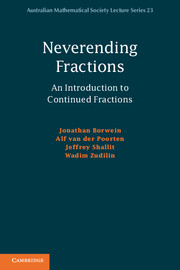Book contents
- Frontmatter
- Contents
- Preface
- 1 Some preliminaries from number theory
- 2 Continued fractions
- 3 Metric theory of continued fractions
- 4 Quadratic irrationals through a magnifier
- 5 Hyperelliptic curves and Somos sequences
- 6 From folding to Fibonacci
- 7 The integer part of qα + β
- 8 The Erdős–Moser equation
- 9 Irregular continued fractions
- Appendix A Selected continued fractions
- References
- Index
- References
References
Published online by Cambridge University Press: 05 July 2014
- Frontmatter
- Contents
- Preface
- 1 Some preliminaries from number theory
- 2 Continued fractions
- 3 Metric theory of continued fractions
- 4 Quadratic irrationals through a magnifier
- 5 Hyperelliptic curves and Somos sequences
- 6 From folding to Fibonacci
- 7 The integer part of qα + β
- 8 The Erdős–Moser equation
- 9 Irregular continued fractions
- Appendix A Selected continued fractions
- References
- Index
- References
Summary

- Type
- Chapter
- Information
- Neverending FractionsAn Introduction to Continued Fractions, pp. 200 - 208Publisher: Cambridge University PressPrint publication year: 2014

